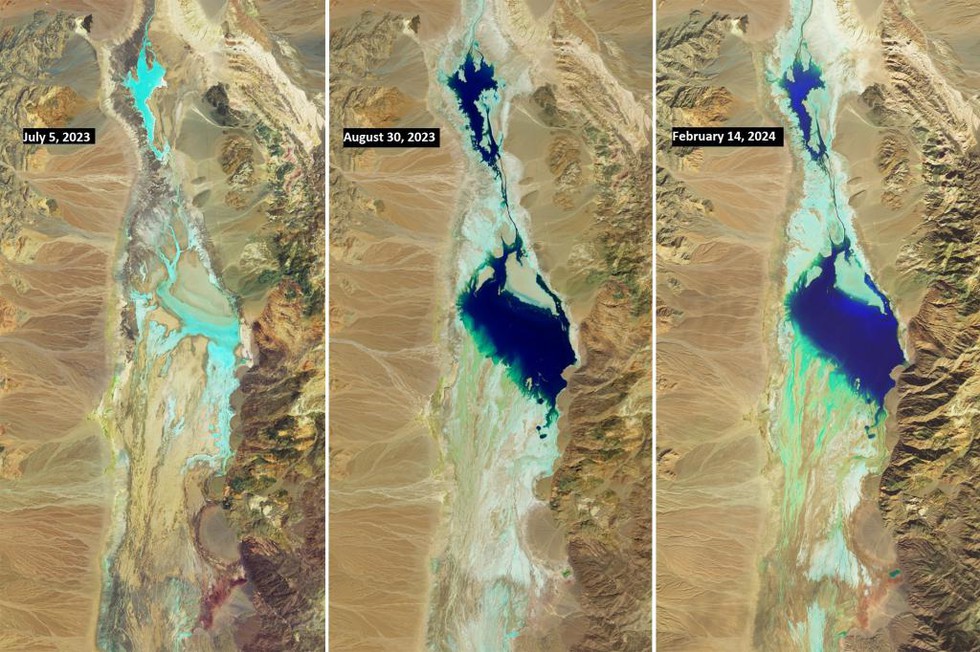In the heart of Death Valley, within the Badwater Basin, an extraordinary phenomenon has occurred. Despite being one of the driest regions in North America, this barren landscape has transformed into an ephemeral lake, defying expectations and captivating observers.
Occurrence after Hurricane Hilary
In August 2023, following the onslaught of Hurricane Hilary, the parched salt flats of Badwater Basin unexpectedly gave rise to a lake, now known as Manly Lake. Initially perceived as a transient event, the lake persisted beyond the anticipated timeframe.
Reinforcement by Atmospheric River
The resilience of Manly Lake was further demonstrated in February 2024, when an atmospheric river replenished its waters, prolonging its existence and expanding its dimensions.
Observing Transformation
The National Aeronautics and Space Administration (NASA) Earth Observatory meticulously recorded the evolution of Badwater Basin through satellite imagery. Images captured before and after extreme weather events vividly depict the basin’s transition from arid terrain to a temporary aquatic landscape.
Illustrative Comparisons
Comparative images released by NASA showcase the drastic alterations in the basin’s appearance, notably following the significant storms of August 2023 and February 2024. These visuals underscore the remarkable transformation of the once-dry expanse into a sprawling shallow lake.
Disruption of Endorheic System
Badwater Basin’s endorheic nature, characterized by inward water flow and minimal outflow, typically results in rapid evaporation and the formation of ephemeral lakes. However, the recent surge in precipitation has disrupted this established pattern.
Anomalous Rainfall
Despite Death Valley’s reputation for minimal rainfall, an exceptional increase in precipitation occurred over the past six months. This anomaly, attributed to two significant weather events, notably exceeded the region’s average annual rainfall.
Dimensions and Depth
At its peak, Manly Lake stretched approximately 11 kilometers in length and 6.5 kilometers in width, with a depth reaching around 60 centimeters. Subsequent fluctuations in water levels resulted in varying dimensions, with February rainfall replenishing depths to approximately 30 centimeters in certain areas.
Prolonged Existence
Contrary to initial expectations, Manly Lake persisted for an unprecedented duration, defying predictions of its rapid dissipation. Park officials, including ranger Abby Wines, expressed astonishment at the lake’s prolonged presence and emphasized its unique aesthetic appeal.
Duration and Speculations
The remarkable longevity of Manly Lake has left park officials uncertain about its future. While its current presence is captivating, the transient nature of such phenomena raises questions regarding its longevity. Speculations suggest the lake may endure until late March, but its eventual fate remains uncertain.
Multiple Choice Questions (MCQs):
- What exceptional event led to the formation of Manly Lake in Badwater Basin?
- A) Earthquake
- B) Hurricane Hilary
- C) Tornado
- D) Heatwave
- Answer: B) Hurricane Hilary
- How did Manly Lake receive reinforcement in February 2024?
- A) Snowfall
- B) Tidal wave
- C) Atmospheric river
- D) Sandstorm
- Answer: C) Atmospheric river
- How did NASA document the transformation of Badwater Basin?
- A) Through ground surveys
- B) Via satellite imagery
- C) Using drones
- D) By aerial photography
- Answer: B) Via satellite imagery
- What disrupted the traditional evaporation pattern in Badwater Basin?
- A) Human intervention
- B) Animal migration
- C) Increased precipitation
- D) Industrial pollution
- Answer: C) Increased precipitation
- What was the approximate length of Manly Lake at its largest?
- A) 5 kilometers
- B) 11 kilometers
- C) 20 kilometers
- D) 30 kilometers
- Answer: B) 11 kilometers
